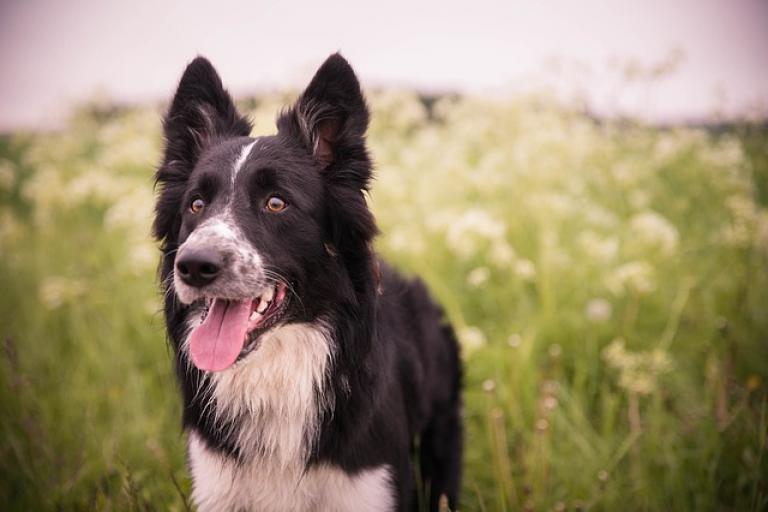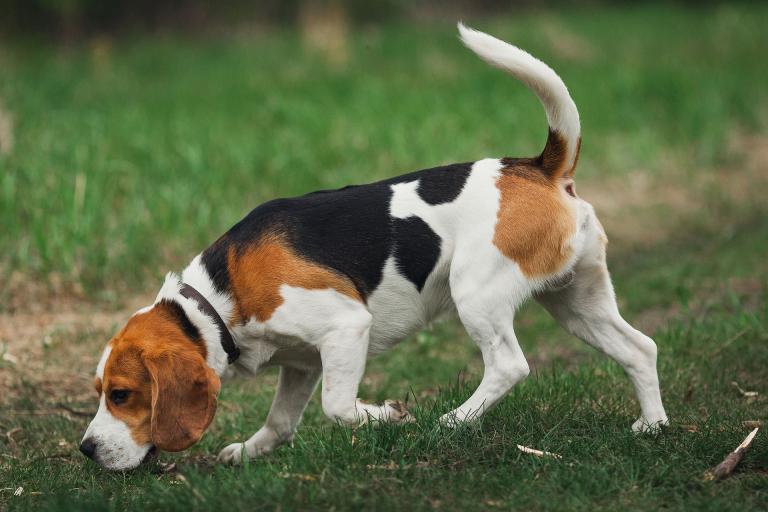Spotting | Piebald (Coat colour S-Locus Dog)
The Piebald colouration is a white spotting pattern in which white patches appear on the body. The extent and position of the spotting can vary greatly. Probable differences in expression between breeds have been noted.
The colour is caused by the s allele of the S locus, through a mutation of the MITF gene. Other alleles of the MITF gene or other genes could influence this phenotype, the individual variations are still unknown and research on this is still ongoing.
Genetic Test: available in Shop
General Information
- The Piebald colouration is a white spotting pattern in which white patches appear on the body.
- The extent and position of the spotting can vary greatly.
- The colour is caused by the s allele of the S locus.
- Probable differences in expression have been noted between breeds.
- Irish Spotting: In breeds such as Great Dane, Australian Shepherd, Collie (Border, Sheltie) a copy of the s-allele results in the phenotype "Irish Spotting", with sporadic white (symetric) markings on paws, tail, face, chest and belly.
- Piebald Spotting: Many breeds such as Jack Russell Terriers, Beagles and other trail dogs show the "Piebald Spotting" phenotype, with larger white patches all over the body.
- Extreme White Piebald:cIn Bull Terriers or Buldogs, one copy of the s allele is sufficient to cause the "Extreme White Piebald" phenotype, where there are only few coloured patches left.
- Two copies of the s-allele often results in increased white, "colour-headed whites" (more than half of the body is white) or completely white dogs.
- The colouration is caused by a mutation of the MITF gene.
- Other alleles of the MITF gene or other genes could influence this phenotype, the individual variations are still unknown and research on this is still ongoing.
Test Information
Locus Information: S-Locus
This test detects an upstream SINE insertion in the MITF gene.
Test in Shop
Also in the Coat colours 'Eurasier' package
Genotype and Lab Report
Inheritance: incomplete autosomal dominant.
→ Animals with one or two copies of the gene (S/s, s/s) show the Piebald phenotype. Incomplete means that animals with only one copy (S/s) show a less pronounced phenotype than animals with two mutant alleles (s/s).
Genotypes:
S/S = No copy for piebald pattern
The dog has no disposition for piebald and shows no piebald (= solid).
S/s = One copy for piebald pattern
The dog shows the pattern and has white patches of varying intensity.
s/s = Two copies for piebald pattern
The dog shows the pattern and is often white in colour over a large area.
Appearance
Literature
Karlsson, E.K., Baranowska, I., Wade, C.M., Salmon Hillbertz, N.H., Zody, M.C., Anderson, N., Biagi, T.M., Patterson, N., Pielberg, G.R., Kulbokas, E.J., Comstock, K.E., Keller, E.T., Mesirov, J.P., von Euler, H., Kämpe, O., Hedhammar, A., Lander, E.S., Andersson, G., Andersson, L., Lindblad-Toh, K.: Efficient mapping of mendelian traits in dogs through genome-wide association. Nat Genet 39:1321-8, 2007. Pubmed reference: 17906626. Doi: 10.1038/ng.2007.10.
Baranowska Körberg, I., Sundström, E., Meadows, J.R., Rosengren Pielberg, G., Gustafson, U., Hedhammar, Å., Karlsson, E.K., Seddon, J., Söderberg, A., Vilà, C., Zhang, X., Åkesson, M., Lindblad-Toh, K., Andersson, G., Andersson, L.: A simple repeat polymorphism in the MITF-M promoter is a key regulator of white spotting in dogs. PLoS One 9:e104363, 2014. Pubmed reference: 25116146. Doi: 10.1371/journal.pone.0104363.
Further information is available at Online Mendelian Inheritance in Animals.



